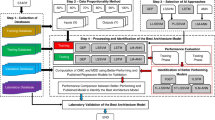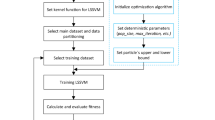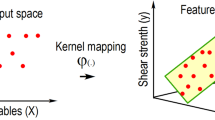Abstract
The soil compaction parameters, i.e., optimum water content (OWC) and maximum dry density (MDD) are essential parameters used in civil engineering projects for monitoring the compaction of soils. The current practice of using laboratory testing to determine the OWC and MDD is time-consuming and costly. Thus, this research suggests a hybrid machine-learning solution to replace traditional soil testing for determining OWC and MDD. The novel method combines the least square support vector machine (LSSVM) and symbiotic organisms search (SOS) algorithm. These two computational intelligence algorithms work together to create an OWC and soil MDD prediction model, LSSVM–SOS. For this purpose, a large database of 13 different soils featuring 6 influencing factors was used. Overall, experimental results show that the proposed LSSVM–SOS has attained the most accurate prediction of the OWC of soils (RMSE = 0.0288, MAE = 0.0199, and R2 = 0.9656) and MDD (RMSE = 0.0305, MAE = 0.0206, and R2 = 0.9641). These results of the proposed model are significantly better than those obtained from other hybrid LSSVMs constructed with particle swarm optimization, grey wolf optimizer, and slime mould optimization algorithms. According to the findings, the newly created LSSVM–SOS can aid geotechnical engineers in the design phase of civil engineering projects.












Similar content being viewed by others
References
Proctor R (1933) Fundamental principles of soil compaction. Engineering News-Record 111(13)
Lim YY, Miller GA (2004) Wetting-induced compression of compacted Oklahoma soils. J Geotech Geoenviron Eng 130(10):1014–1023
Rahman F, Hossain M, Hunt MM, Romanoschi SA (2008) Soil stiffness evaluation for compaction control of cohesionless embankments. Geotech Test J 31(5):442–451
Wang HL, Chen RP, Qi S, Cheng W, Cui YJ (2018) Long-term performance of pile-supported ballastless track-bed at various water levels. J Geotech Geoenviron Eng 144(6):04018035
Chen RP, Qi S, Wang HL, Cui YJ (2019) Microstructure and hydraulic properties of coarse-grained subgrade soil used in high-speed railway at various compaction degrees. J Mater Civ Eng 31(12):04019301
Uyanik O, Ulugergerli EU (2008) Quality control of compacted grounds using seismic velocities. Near Surface Geophys 6(5):299–306
Wang X, Huang H, Tutumluer E, Tingle JS, Shen S (2022) Monitoring particle movement under compaction using SmartRock sensor: a case study of granular base layer compaction. Transp Geotech 34:100764
Xu C, Chen ZQ, Li JS, Xiao YY (2014) Compaction of subgrade by high-energy impact rollers on an airport runway. J Perform Constr Facil 28(5):04014021
Günaydın OJEG (2009) Estimation of soil compaction parameters by using statistical analyses and artificial neural networks. Environ Geol 57(1):203–215
Wang HL, Yin ZY (2020) High performance prediction of soil compaction parameters using multi expression programming. Eng Geol 276:105758
Kurnaz TF, Kaya Y (2020) The performance comparison of the soft computing methods on the prediction of soil compaction parameters. Arab J Geosci 13(4):1–13
Verma G, Kumar B (2020) Prediction of compaction parameters for fine-grained and coarse-grained soils: a review. Int J Geotech Eng 14(8):970–977
Sinha SK, Wang MC (2008) Artificial neural network prediction models for soil compaction and permeability. Geotech Geol Eng 26(1):47–64
Ahangar-Asr A, Faramarzi A, Mottaghifard N, Javadi AA (2011) Modeling of permeability and compaction characteristics of soils using evolutionary polynomial regression. Comput Geosci 37(11):1860–1869
Ardakani A, Kordnaeij A (2019) Soil compaction parameters prediction using GMDH-type neural network and genetic algorithm. Eur J Environ Civ Eng 23(4):449–462
Raja MNA, Shukla SK (2021) Predicting the settlement of geosynthetic-reinforced soil foundations using evolutionary artificial intelligence technique. Geotext Geomembr 49(5):1280–1293
Raja MNA, Jaffar STA, Bardhan A, Shukla SK (2022) Predicting and validating the load-settlement behavior of large-scale geosynthetic-reinforced soil abutments using hybrid intelligent modeling. J Rock Mech Geotech Eng. https://doi.org/10.1016/j.jrmge.2022.04.012
Bardhan A, GuhaRay A, Gupta S, Pradhan B, Gokceoglu C (2022) A novel integrated approach of ELM and modified equilibrium optimizer for predicting soil compression index of subgrade layer of dedicated freight corridor. Transp Geotech 32:100678
Taghavifar H, Mardani A, Taghavifar L (2013) A hybridized artificial neural network and imperialist competitive algorithm optimization approach for prediction of soil compaction in soil bin facility. Measurement 46(8):2288–2299
Trong DK, Pham BT, Jalal FE, Iqbal M, Roussis PC, Mamou A, Asteris PG (2021) On random subspace optimization-based hybrid computing models predicting the California bearing ratio of soils. Materials 14(21):6516
Zhang W, Li H, Li Y, Liu H, Chen Y, Ding X (2021) Application of deep learning algorithms in geotechnical engineering: a short critical review. Artif Intell Rev 54(8):5633–5673
Zhang W, Li H, Han L, Chen L, Wang L (2022) Slope stability prediction using ensemble learning techniques: a case study in Yunyang County, Chongqing, China. J Rock Mech Geotech Eng. https://doi.org/10.1016/j.jrmge.2021.12.011
Zhang W, Phoon KK (2022) Editorial for advances and applications of deep learning and soft computing in geotechnical underground engineering. J Rock Mech Geotechn Eng
Zhang W, Liu Z (2022) Editorial for machine learning in geotechnics. Acta Geotech 17:1017. https://doi.org/10.1007/s11440-022-01563-z
Zhang W, Li H, Tang L, Gu X, Wang L, Wang L (2022) Displacement prediction of Jiuxianping landslide using gated recurrent unit (GRU) networks. Acta Geotech 17(4):1367–1382
Zhang W, Gu X, Tang L, Yin Y, Liu D, Zhang Y (2022) Application of machine learning, deep learning and optimization algorithms in geoengineering and geoscience: comprehensive review and future challenge. Gondwana Res
Zhang W, Zhang R, Wu C, Goh ATC, Lacasse S, Liu Z, Liu H (2020) State-of-the-art review of soft computing applications in underground excavations. Geosci Front 11(4):1095–1106
Wang L, Zhang W, Chen F (2019) Bayesian approach for predicting soil-water characteristic curve from particle-size distribution data. Energies 12(15):2992
Zhang W, Zhang Y, Goh AT (2017) Multivariate adaptive regression splines for inverse analysis of soil and wall properties in braced excavation. Tunn Undergr Space Technol 64:24–33
Zhang W, Zhang R, Goh AT (2018) Multivariate adaptive regression splines approach to estimate lateral wall deflection profiles caused by braced excavations in clays. Geotech Geol Eng 36(2):1349–1363
Tien Bui D, Hoang ND, Nhu VH (2019) A swarm intelligence-based machine learning approach for predicting soil shear strength for road construction: a case study at Trung Luong national expressway project (Vietnam). Eng Comput 35(3):955–965
Cai M, Hocine O, Mohammed AS, Chen X, Amar MN, Hasanipanah M (2021) Integrating the LSSVM and RBFNN models with three optimization algorithms to predict the soil liquefaction potential. Eng Comput 38(4):3611–3623
Deng J, Chen X, Du Z, Zhang Y (2011) Soil water simulation and predication using stochastic models based on LS-SVM for red soil region of China. Water Resour Manage 25(11):2823–2836
Suykens JA, Van Gestel T, De Brabanter J, De Moor B, Vandewalle JP (2002) Least squares support vector machines. World Scientific
Zhang Y, Li R (2022) Short term wind energy prediction model based on data decomposition and optimized LSSVM. Sustain Energy Technol Assess 52:102025
Kennedy J, Eberhart R (1995) Particle swarm optimization. In: Proceedings of ICNN’95-international conference on neural networks, vol. 4. IEEE, pp 1942–1948
Topal U, Goodarzimehr V, Bardhan A, Vo-Duy T, Shojaee S (2022) Maximization of the fundamental frequency of The FG-CNTRC quadrilateral plates using a new hybrid PSOG algorithm. Compos Struct 115823
Mirjalili S, Mirjalili SM, Lewis A (2014) Grey wolf optimizer. Adv Eng Softw 69:46–61
Li S, Chen H, Wang M, Heidari AA, Mirjalili S (2020) Slime mould algorithm: a new method for stochastic optimization. Futur Gener Comput Syst 111:300–323
Cheng MY, Prayogo D (2014) Symbiotic organisms search: a new metaheuristic optimization algorithm. Comput Struct 139:98–112
Raja MNA, Shukla SK (2020) An extreme learning machine model for geosynthetic-reinforced sandy soil foundations. Proc Inst Civil Eng-Geotech Eng 175(4):383–403
Raja MNA, Shukla SK, Khan MUA (2021) An intelligent approach for predicting the strength of geosynthetic-reinforced subgrade soil. Int J Pavement Eng 23(10):3505–3521
Raja MNA, Shukla SK (2021) Multivariate adaptive regression splines model for reinforced soil foundations. Geosynth Int 28(4):368–390
Khan MUA, Shukla SK, Raja MNA (2021) Soil–conduit interaction: an artificial intelligence application for reinforced concrete and corrugated steel conduits. Neural Comput Appl 33(21):14861–14885
Khan MUA, Shukla SK, Raja MNA (2022) Load-settlement response of a footing over buried conduit in a sloping terrain: a numerical experiment-based artificial intelligent approach. Soft Comput 26:6839–6856
Aamir M, Tolouei-Rad M, Vafadar A, Raja MNA, Giasin K (2020) Performance analysis of multi-spindle drilling of Al2024 with TiN and TiCN coated drills using experimental and artificial neural networks technique. Appl Sci 10(23):8633. https://doi.org/10.3390/app10238633
Hasthi V, Raja MNA, Hegde A, Shukla SK (2022) Experimental and intelligent modelling for predicting the amplitude of footing resting on geocell-reinforced soil bed under vibratory load. Transp Geotech 100783
Ghani S, Kumari S, Bardhan A (2021) A novel liquefaction study for fine-grained soil using PCA-based hybrid soft computing models. Sādhanā 46(3):1–17
Kardani N, Aminpour M, Raja MNA, Kumar G, Bardhan A, Nazem M (2022) Prediction of the resilient modulus of compacted subgrade soils using ensemble machine learning methods. Transp Geotech 36:100827
Khan K, Iqbal M, Jalal FE, Amin MN, Alam MW, Bardhan A (2022) Hybrid ANN models for durability of GFRP rebars in alkaline concrete environment using three swarm-based optimization algorithms. Constr Build Mater 352:128862
Salami BA, Iqbal M, Abdulraheem A, Jalal FE, Alimi W, Jamal A, Tafsirojjaman T, Liu X, Bardhan A (2022) Estimating compressive strength of lightweight foamed concrete using neural, genetic and ensembled machine learning approach. Cem Concrete Compos 133:104721
Taylor KE (2001) Summarizing multiple aspects of model performance in a single diagram. J Geophys Res: Atmos 106(D7):7183–7192
Samadi M, Sarkardeh H, Jabbari E (2020) Explicit data-driven models for prediction of pressure fluctuations occur during turbulent flows on sloping channels. Stoch Env Res Risk Assess 34(5):691–707
Gandomi AH, Alavi AH, Sahab MG, Arjmandi P (2010) Formulation of elastic modulus of concrete using linear genetic programming. J Mech Sci Technol 24(6):1273–1278
Funding
No funding has been received for this work.
Author information
Authors and Affiliations
Corresponding author
Ethics declarations
Conflict of interest
The authors declared that they have no conflict of interest.
Rights and permissions
Springer Nature or its licensor (e.g. a society or other partner) holds exclusive rights to this article under a publishing agreement with the author(s) or other rightsholder(s); author self-archiving of the accepted manuscript version of this article is solely governed by the terms of such publishing agreement and applicable law.
About this article
Cite this article
Tiwari, L.B., Burman, A. & Samui, P. Modelling soil compaction parameters using a hybrid soft computing technique of LSSVM and symbiotic organisms search. Innov. Infrastruct. Solut. 8, 2 (2023). https://doi.org/10.1007/s41062-022-00966-x
Received:
Accepted:
Published:
DOI: https://doi.org/10.1007/s41062-022-00966-x




